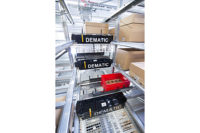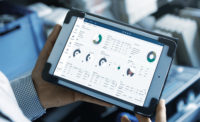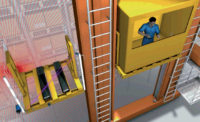Jump to: AS/RS Trends from ProMat, Automate 2013
It used to be that automated storage retrieval systems (AS/RS) were almost as cumbersome as the high-volume loads they were handling. But, thanks to some technological advancements and an industry hard-pressed to save time, labor and costs, today’s AS/RS have transformed into quite the multi-tasking machine.
AS/RS solutions that provide high degree of density and cube utilization are prominent in refrigerated and frozen foods, says Brad Moore, vice president of AGVPick and global accounts for Swisslog WDS NA, Newport News, Va.
“Pallet-handling systems of multi-deep are very common among the production plants and large distribution centers. When automated case selection is important, mini-loads and carousels are the primary AS/RS technologies available to limit labor in the harsh environment,” he adds.
Plus, Swisslog’s AS/RS solutions are flexible enough to be adapted to a wide range of customer requirements, including storage, order selection, sequencing and cold chain compliance.
For its part, Dematic Corp., Lisle, Ill., introduced the Multishuttle case storage/buffering/sequencing system for freezer applications. Dubbed as the next generation system for AS/RS of cases, totes and trays, it is designed to enhance the interface between bulk stock and functions like picking, order assembly and sequencing, while dramatically increasing speed, accuracy and throughput.
“Dematic’s Multishuttle is redefining warehouse logistics. [With] the trend of smaller, more frequent orders and the growth of SKUs in fresh and frozen products, the multi-faceted Multishuttle is becoming a key productivity solution for the food industry,” says Sean O’Farrell, market development director. “The Multishuttle’s ability to stage, buffer and sequence cases and totes automatically in a very small footprint allows food companies to grow their SKUs in the same building.”
The Multishuttleis 7-10 times faster than conventional storage systems, according to O’Farrell, and can handle a large range of load types.
Kardex Remstar, LLC, Westbrook, Maine, developed a Logicontrol machine, designed specifically for smaller warehouses and stand-alone solutions. It combines hardware, basic software and an operator terminal into a touch-screen control that can operate up to three storage systems and manage up to 1,000 different articles, 8,000 storage locations and seven bin sizes.
“For specialty products, we offer stand-alone systems that have temperature ranges from -60°C (deep freeze), -20°C (freezer), 2-8°C (refrigerated), ambient (normally room temp), heated and humidity control (this is important for vegetation to keep it from drying out),” says Tim Harrison, systems and specialty applications project manager.
Westfalia Technologies, Inc., York, Pa., constructed its fourth generation storage retrieval machine (SRM) that combined with Savanna.NET warehouse management system (WMS), maximizes available storage space in existing structures, minimizes building footprint, reduces energy costs by average of 40% in cooler environments, reduces labor and product damage costs and increases accuracy and customer service, among other functions.
“For Westfalia, the smallest system deployed is about 500 positions and the largest approximately 42,000 positions,” says Dan Labell, president. “There really are no building size requirements. We have installed many systems in regular industrial buildings with ceiling heights of 20-35 feet. One advantage is the ability to go up rather than out. An AS/RS utilizes a storage/retrieval machine to replace forklifts. These machines are typically rail mounted and electrically powered. As such, they can be constructed up to 150 feet tall. The highest system Westfalia has installed is approximately 140 feet tall. These types of buildings (generally termed ‘rack-supported buildings,’ as the wall and roof systems are attached directly to the rack structure) are generally built when land is in short supply, or companies have no choice but to build up, rather than out.”
Sapient Automation offers an assortment of case-handling crane AS/RS, pallet-handling and carousels with extractors for the refrigerated and frozen foods industry, says Colman Roche, executive vice president for the Hatfield, Pa., company.
“All of these provide better utilization of resources, whether capital or human,” he adds. “They are inherently more efficient with fewer processing errors, less
“All of these provide better utilization of resources, whether capital or human,” he adds. “They are inherently more efficient with fewer processing errors, less damage and very quick response to filling orders." |
damage and very quick response to filling orders. In addition, they remove most staff from cold environment, which will continue to increase in importance with an aging workforce. Goods can be shipped directly to palletizing stations, or if needed, be delivered to ergonomic workstations in more temperature-friendly environments for other processing.”
Today’s AS/RS machines have become quite the multi-tasking machine, allowing you to focus time and efforts on other areas of the plant.
AS/RS Trends from ProMat, Automate 2013
1. Storing slow-moving SKUs.“Companies are investigating storing slow-moving SKUs on a half pallet in columns instead of layers,” says Sean O’Farrell, market development director for Dematic Corp., Lisle, Ill. “This will allow the pallet opening in the rack to hold two half pallets of one SKU each. Plus, after the order is picked, palletized and stretch-wrapped, the order pallet can go back into the AS/RS until the trailer is ready to be loaded for transport.”
2. Goods-to-man technologies. Companies are showing an increased adoption of automated goods-to-man technologies, according to Colman Roche, executive vice president of Sapient Automation, Hatfield, Pa. “North America is fast catching up with European competitors in terms of adopting such technologies, and recognizing the benefits when comparing their existing key performance indicators against best-of-breed.”
3. Case picking, layer picking.“A well-designed system integrates the reserve storage and re-supply of product to some type of order selection process, whether automated, semi-automated or manual,” says Dan Labell, president of Westfalia Technologies, Inc., York, Pa.
4. Density, cube utilization.Multi-deep pallet handling systems are becoming more common among production plants and large distribution centers, says Brad Moore, vice president of AGVPick and global accounts for Swisslog WDS NA, Newport News, Va. “When automated case selection is important, mini-loads and carousels are the primary AS/RS technologies available to limit labor in the harsh environments.”
Read ProMat, Automate: Where Supply Chain Solutions Come to Life to find out what new AS/RS solutions were introduced at the ProMat/Automate show.







